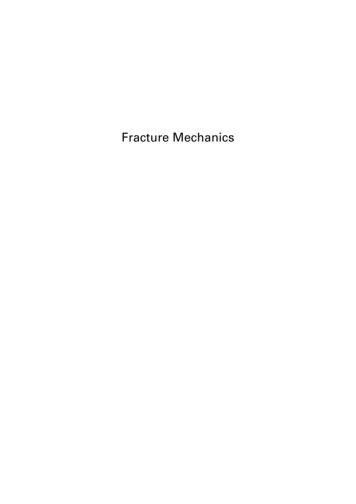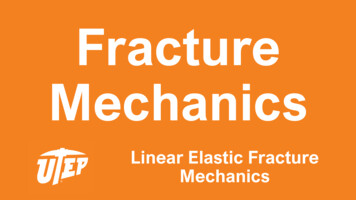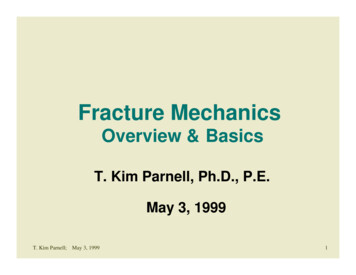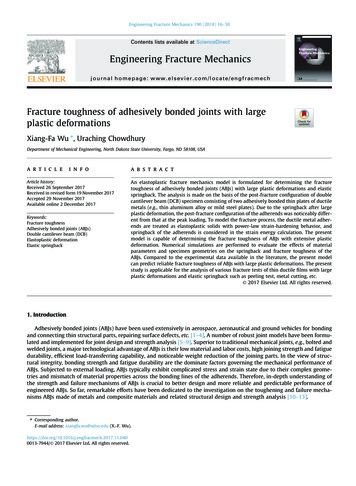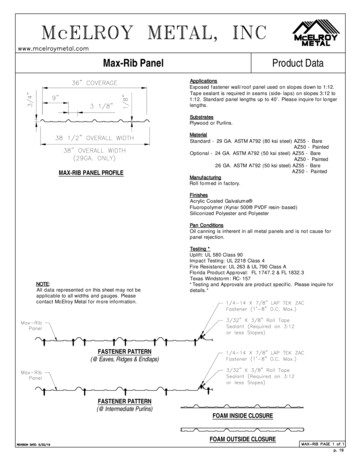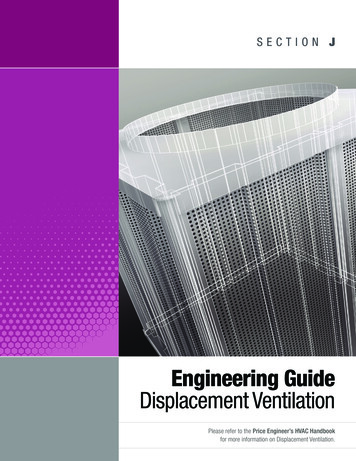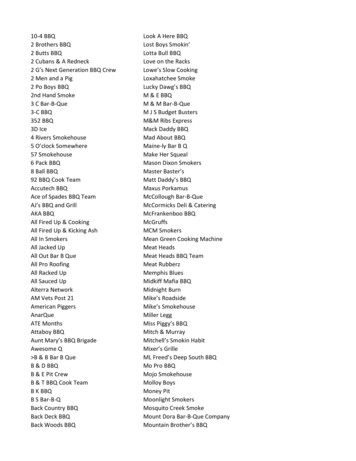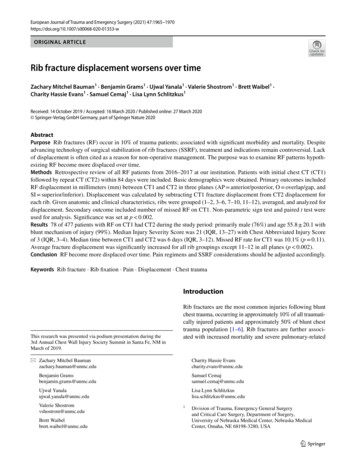
Transcription
European Journal of Trauma and Emergency Surgery (2021) 1353-wORIGINAL ARTICLERib fracture displacement worsens over timeZachary Mitchel Bauman1 · Benjamin Grams1 · Ujwal Yanala1 · Valerie Shostrom1 · Brett Waibel1 ·Charity Hassie Evans1 · Samuel Cemaj1 · Lisa Lynn Schlitzkus1Received: 14 October 2019 / Accepted: 16 March 2020 / Published online: 27 March 2020 Springer-Verlag GmbH Germany, part of Springer Nature 2020AbstractPurpose Rib fractures (RF) occur in 10% of trauma patients; associated with significant morbidity and mortality. Despiteadvancing technology of surgical stabilization of rib fractures (SSRF), treatment and indications remain controversial. Lackof displacement is often cited as a reason for non-operative management. The purpose was to examine RF patterns hypothesizing RF become more displaced over time.Methods Retrospective review of all RF patients from 2016–2017 at our institution. Patients with initial chest CT (CT1)followed by repeat CT (CT2) within 84 days were included. Basic demographics were obtained. Primary outcomes includedRF displacement in millimeters (mm) between CT1 and CT2 in three planes (AP anterior/posterior, O overlap/gap, andSI superior/inferior). Displacement was calculated by subtracting CT1 fracture displacement from CT2 displacement foreach rib. Given anatomic and clinical characteristics, ribs were grouped (1–2, 3–6, 7–10, 11–12), averaged, and analyzed fordisplacement. Secondary outcome included number of missed RF on CT1. Non-parametric sign test and paired t test wereused for analysis. Significance was set at p 0.002.Results 78 of 477 patients with RF on CT1 had CT2 during the study period: primarily male (76%) and age 55.8 20.1 withblunt mechanism of injury (99%). Median Injury Severity Score was 21 (IQR, 13–27) with Chest Abbreviated Injury Scoreof 3 (IQR, 3–4). Median time between CT1 and CT2 was 6 days (IQR, 3–12). Missed RF rate for CT1 was 10.1% (p 0.11).Average fracture displacement was significantly increased for all rib groupings except 11–12 in all planes (p 0.002).Conclusion RF become more displaced over time. Pain regimens and SSRF considerations should be adjusted accordingly.Keywords Rib fracture · Rib fixation · Pain · Displacement · Chest traumaIntroductionThis research was presented via podium presentation during the3rd Annual Chest Wall Injury Society Summit in Santa Fe, NM inMarch of 2019.Rib fractures are the most common injuries following bluntchest trauma, occurring in approximately 10% of all traumatically injured patients and approximately 50% of blunt chesttrauma population [1–6]. Rib fractures are further associated with increased mortality and severe pulmonary-related* Zachary Mitchel Baumanzachary.bauman@unmc.eduCharity Hassie Evanscharity.evans@unmc.eduBenjamin Gramsbenjamin.grams@unmc.eduSamuel Cemajsamuel.cemaj@unmc.eduUjwal Yanalaujwal.yanala@unmc.eduLisa Lynn Schlitzkuslisa.schlitzkus@unmc.eduValerie Shostromvshostrom@unmc.eduBrett Waibelbrett.waibel@unmc.edu1Division of Trauma, Emergency General Surgeryand Critical Care Surgery, Department of Surgery,University of Nebraska Medical Center, Nebraska MedicalCenter, Omaha, NE 68198‑3280, USA13Vol.:(0123456789)
1966morbidity [1–4, 6–8]. Patients with eight or more rib fractures have a mortality rate of 34.4% with more than half ofthese patients requiring intensive-care unit (ICU) admission[9]. Over one-third will develop pulmonary complications andone-third require discharge to an extended care facility [4, 10].Furthermore, as the population continues to age worldwide,rib injury frequency and the associated morbidity and mortality will continue to increase as older individuals are morevulnerable and more likely to die as a result of chest injuries[7, 8, 11, 12].Over the past decade, vast improvements have been made inthe care of the rib fractured patient; however, outcomes for thispatient population still remain poor and with little change [1,3, 6]. The main clinical manifestation of rib fractures is chestwall pain, which is often the principal cause of the underlyingmorbidity and mortality [13, 14]. Multiple modalities havebeen proposed for managing rib fracture pain including bothopioid and nonopioid pain medications, delivered enterally,parenterally, topically, or through regional means [13, 15–20].Recently, surgical stabilization of rib fractures (SSRF) has gainpopularity in the management of patients with rib fractures tohelp reduce pain and the development of associated complications. However, there still remains uncertainty about whichpatients would benefit from SSRF [1, 2, 6, 9, 14, 21–23].Lack of rib fracture displacement is often cited as a reasonfor non-operative intervention for rib fracture patients. Reviewof current literature often describes “severely displaced” ribfractures as an indication for SSRF, with “severely displaced”defined as anywhere from 50% rib thickness transposition tobi-cortical displacement [1, 23–27]. Furthermore, the RibScore developed in 2015 defined “severely displaced” as displacement greater than the diameter of the rib with total loss ofcontact between the proximal and distal segments [28]. Whilemany rib fracture patients present with severely displaced fractures, many do not have any signs of displacement on theirinitial CT. The question then becomes what happens to theirrib fractures over time and would these individuals potentiallybenefit from SSRF earlier in their hospital course? Expansionof the thoracic cavity is a cyclically derived reflex necessaryfor life. It is conducted in three planes (vertical, anteroposterior, and transverse) with average adult chest expansion ranging from 3 to 5 cm on inhalation [29]. Given chest wall physiology and constant movement of the chest with inspirationand exhalation, the aim of this study was to assess rib fracturedisplacement over time. We hypothesized that rib fractureswould become more displaced with time.MethodsThis was an Institutional Review Board approved retrospective review study. All trauma patients from 2016 to 2017admitted to our Level I, academic trauma center with rib13Z. M. Bauman et al.fractures were evaluated for the study. Basic demographicsincluding age, gender, Injury Severity Score (ISS), ChestAbbreviated Injury Score (c-AIS), ICU and hospital lengthof stay, presence of a flail chest, and status of patient atdischarge were further extracted from our trauma registry.ISS is an established medical score assessing the overallseverity of a major trauma (greater than 15 is consideredmajor trauma). c-AIS is an anatomic score representing justthe severity of the thoracic cavity injury itself. Patients wereincluded in the study if they had an initial chest computedtomography (CT1) followed by a second chest computedtomography (CT2) within 84 days of injury. Current literature suggests that rib fractures heal within 6–12 weeks [30];hence, the reason 84 days was chosen for repeat CT criteriain this study. The CT2 was obtained for a variety of reasonsincluding, but not limited to, assessment for the presence ofa hemothorax or pleural effusion, to rule out a pulmonaryembolism, assessment of vascular abnormality, and assessment of thoracic spine injury/repair, or to evaluate for anempyema. All patients underwent CT scanning at our institution utilizing a helical scan with 1.25 mm slices. The CTscan was obtained through the apices of the lung superiorlyand the top of the kidneys inferiorly with standard reconstruction. With varying body habitus, the approximate number of CT slices was anywhere from 225 to 250 per patient.Rib fracture displacement was then measured in millimeters (mm) in three different planes: anterior–posterior (AP),overlap or gap (O), and superior–inferior (SI). All imageswere digital using McKesson Radiology software (12.1.1).The site of the rib fracture served as the reference point formeasurements between CT 1 and CT2, and the outer cortexof the rib was used for the measurements. Utilizing the builtin measuring software for McKesson Radiology (12.1.1),distances were obtained in the three planes, making sure tomaintain the same angle for measurements between CT1 andCT2 further utilizing the angle management software builtinto McKesson Radiology (12.1.1).The primary outcome of the study was the differencein displacement of the rib fractures in all three planesbetween CT1 and CT2. Rib displacement for each planewas calculated by subtracting the initial fracture displacement measurement (CT1) from the follow-up displacementmeasurement (CT2) for each rib. Given the large amountof data generated for this study, the decision was made togroup rib fractures based on anatomic and clinical characteristics. Ribs were grouped as follows; ribs 1–2, ribs3–6, ribs 7–10, and ribs 11–12. Ribs 1 and 2 are high inthe rib cage and fractures here are often associated withhigh mortality (36%) and high likelihood of concomitantinjuries given underlying structures [9, 31]. Furthermore,SSRF does not confer additional pain relief or chest wallstability. [1] Ribs 4–10 are the most commonly fracturedribs [9, 27], but we separated the groupings into 3–6, as
Rib fracture displacement worsens over time 1967fractures here can be under the scapula, and 7–10, as thereare no additional overlying structures other than muscleobstructing these ribs. Finally, ribs 11 and 12 are freefloating, and again, there does not appear to be a chest wallstabilization or pain relief benefit from SSRF of these fractures. [1] Once the displacement between CT1 and CT2was determined, the differences amongst the rib groupswere averaged and analyzed. The secondary outcome forthe study was the number of rib fractures missed fromCT1 to CT2. Non-parametric sign test and paired t testwere used for analysis. Statistical significance was set at ap value of 0.002 given multiple comparisons.Table 1 DemographicsVariableAge (years)(SD)Male genderBlunt injury mechanismInjury severity score (IQR)Chest abbreviated injury score (IQR)Flail segment presentAverage number of rib fractures on CT1Average number of rib fractures on CT2Median days between CT1 and CT2 (IQR)Hospital LOS (IQR)ICU LOS (IQR)Discharged alive55.8 20.176%99%21 (13, 27)3 (3.4)36%566 (3, 12)13 (8, 21)3 (0, 10)96%ResultsA total of 477 patients with rib fractures on CT1 werereviewed during the 2-year study period. Only 78 of thesepatients met inclusion criteria having undergone a repeatchest CT within the allotted 84 days. A total of 461 ribfractures were compared between CT1 and CT2. Patientswere primarily male (76%), aged 55.8 20.1 years withblunt trauma serving at the primary mechanism of injury(99%). Median ISS was 21 [inter-quartile range (IQR)13–27] with a median c-AIS of 3 (IQR, 3–4). Demographics are displayed in Table 1. Median time between CT1and CT2 was 6 days (IQR, 3–12).When analyzing our primary outcome, all rib groupings, expect the 11–12 group, demonstrated statisticallysignificant increases in the displacement between CT1 andCT2 in all three planes of measurement. Rib group 11–12did not show any increase in displacement between CT1and CT2. Of note, there were not as may rib fractures foranalysis in this group as there are for the other groupings.Table 2 demonstrates the results for the primary outcome.Upon analysis of our secondary outcome, a total of 513rib fractures were found on CT2 (CT1 average 5 ribfractures; CT2 average 6 rib fractures). Therefore, CT1missed 52 rib fractures resulting in a missed rib fracturerate of 10.1% on initial chest CT. This was not statisticallysignificant (p 0.11).IQR inter-quartile range, CT computed tomography, SD standarddeviationTable 2 Average rib fracturedisplacementViewAPOSIGroupingRibs 1–2Ribs 3–6Ribs 7–10Ribs 11–12Ribs 1–2Ribs 3–6Ribs 7–10Ribs 11–12Ribs 1–2Ribs 3–6Ribs 7–10Ribs 11–12LeftRightnDisplacement (mm)SDp valuenDisplacement (mm)SDp 20.6820.8481.2771.0731.9160.6731.2651.3861.780 0.0001 0.0001 0.0001NS 0.0001 0.0001 0.0001NS0.0005 0.0001 .0011 0.0001 0.0001NS0.00010.0001 0.0001NS0.0009 0.0001 0.0001NSAP anterior/posterior view, O overlap or gapped view, SI superior/inferior, n number of patients, mm millimeters, SD standard deviation, NS not significant13
1968DiscussionTo the authors’ knowledge, this is first study to examinethe natural occurrence of acute rib fracture displacementover time. Our study demonstrated that all rib fractures,except fractured ribs 11 and 12, become significantly moredisplaced over time. Given the constant movement of therib cage, this would intuitively make sense; however, ithad never been demonstrated quantitatively until now. Furthermore, our study demonstrated a relatively low missedrib fracture rate on initial chest CT scan of only 10.1%.This is approximately half of previously described missedfracture rates of 20.7% [4, 32]. Although the exact causeof this decrease in missed fracture rate is outside the scopeof this study, one could contribute this to better CT scantechnology utilizing a helical scan with 1.25 mm slices.Rib fractures can be a debilitating injury with significant morbidity and mortality. The rib cage and muscularattachments provide significant protection for an arrayof very important internal structures as well as provide agreat deal of thoracic stability. In a recent study by Brasiliense et al., intact ribs, on average, accounted for 78%of thoracic stability [33]. Based on these findings, someauthors suggest that the rib cage could represent a “fourthcolumn” of stability for the thoracic spine [33, 34]. Ourstudy negatively affects this concept suggesting that as ribfractures become more displaced over time, so too may thestability of the chest wall resulting in worse complicationsand disability.One of the main clinical manifestations of rib fractures is chest wall pain [13]. It has been well establishedin trauma literature that poorly controlled chest pain isassociated with an increased risk of complications suchas atelectasis, pneumonia, acute respiratory distress syndrome, and ventilator dependence which can further resultin increased hospital length of stay complications, mortality, and long-term disabilities [13, 35–38]. A recent studyby Bugaev et al. showed that the magnitude of rib fracturedisplacement and the number of rib fractures can predictopioid requirements [13]. For every 5 mm increase in totalchest wall displacement, there was an increase in morphineequianalgesic dose (MED) by 6.3% [13]. Every additionalrib fracture was associated with an 11.2% increase in MED[13]. This finding has significant relevance to our study.For example, if a patient with rib fractures has worseningdisplacement over time, in theory, this could lead to worsepain control for the patient as well as an increased need foropioids utilizing standard pain control protocols, leadingto opioid overdose, hypercarbic respiratory failure, andintubation in the ICU. Furthermore, if 10% of rib fractures are missed at the initial chest CT, it is possible thatstandard pain control strategies may be undertreating the13Z. M. Bauman et al.true severity of the injury. This, in turn, may be one of thereasons conventional pain control strategies fail over time.Surgical fixation of rib fractures has recently been gaining popularity in the chest trauma community as anothermanagement option for patients with rib fractures [1, 6, 13,27, 39]. Although there is a clear indication for SSRF inthe flail chest patient [23, 40–42], indications for operativeintervention outside this patient population still remain controversial [1, 2, 6, 9, 14, 21–24]. Consensus among the SSRFcommunity would suggest that there is a lack of evidencefor the fixation of ribs 1, 2, 11, and 12 in terms of providing additional benefit for chest wall stability or pain controlexcept in rare circumstances and in fact, repairing ribs 1 and2 can often prove very challenging and risky given underlying structures in that area of the thoracic cavity [1, 23, 26,27]. For the remaining ribs, 3 through 10, a common indication for SSRF is severely displaced fractures which, as statedabove, is defined as anywhere from displacement of 1/2 oftotal rib thickness to complete bi-cortical displacement ofthe fracture [1, 23–27, 39]. This definition is often based onthe initial chest CT which the patient receives upon arrival.Our study suggests that rib fractures become significantly more displaced over time. Given these findings, theauthors would infer that lack of severe displacement at thetime of presentation does not predict future displacement.The amount of rib fracture displacement for our study onlyranged from 1.2 to 5.1 mm, but when the average thickness of a rib is 8.4 mm and the average height is 12 mm[43], the amount of displacement over time could resultin severe displacement of that fracture. Furthermore, itis important to remember that the ribs change shape andthickness as they traverse the chest wall [43]. Therefore,severe fracture displacement could result with less actualdisplacement over time at various locations throughoutthe rib. For example, if a rib measured 8 mm thick andthe first image of the fracture showed 3 mm displacementin the AP plane, if displacement worsened by only 2 mm,the total displacement would be 5 mm, turning this fracture into a severely displaced rib fracture by definition.This could make one re-evaluate the SSRF indicationof severely displaced fractures present at admission bybroadening it to include patients with mildly displaced ribfractures at presentation knowing that they may progressto severely displaced fractures over time. Furthermore, astudy by Marasco et al. in 2014 qualitatively demonstratedthat fixating only one rib fracture per rib in a flail segment does not necessarily avoid worsening deformity and/or displacement of the non-fixated rib fracture, especiallywhen the non-fixated rib fracture is posterior [44]. Despitethe uncertainty as to whether the worsened deformity and/or displacement was a direct result of the single fracturefixation per rib in the flail chest versus natural rib fracture healing pathophysiology, utilizing Marasco’s study in
Rib fracture displacement worsens over time conjunction with our study further strengthens the SSRFconsideration in patients with initial minimally displacedfractures, especially if they have a flail chest.Despite this being a novel study with multiple statisticallysignificant findings supporting our hypothesis, there still areseveral limitations. First, this is a single center, retrospective review. Ideally, a prospective, multi-institutional studywould help to alleviate institutional and healthcare providerbias. Second, this was a small-sample size. Despite reviewing 477 charts of patients with rib fractures on CT1, only 78patients met inclusion criteria by undergoing a second CTwithin the 84-day time period. A larger sample size couldprovide more clarity in the displacement of rib fractures overtime. Third, the repeat CT scan was not conducted at a specific time, rather at the discretion of the treating physician.Given this variability in the amount of time from CT1 toCT2 and our small-sample size, we were unable to determine what the ideal time frame was to maximum rib fracturedisplacement, as the authors feel this would be very interesting and of benefit to the reader. Thus, repeat CT scanningto determine timing of displacement is being considered ina protocol for future studies. Fourth, we did not examinethe clinical relevance of increased rib fracture displacementover time. Although one can speculate, future studies arerequired to assess the relationship between clinical outcomesand the finding of increased rib fracture displacement. Fifth,although attempts were made at standardization betweenCT1 and CT2 by patient positioning and having the scancompleted during inspiration, this was not always guaranteedgiven patient condition and/or inability to follow commands.Finally, the rib fracture groupings which we provided forour analysis may not be a true representation of each individual rib. Although these ribs do have several anatomic,physiologic, and clinical properties in common, they are allindividual and could potentially be affected differently whenit comes to displacement over time.ConclusionRib fractures become significantly more displaced over time.Furthermore, 10% of rib fractures are missed on initial chestCT. Although the clinical relevance and specific displacement patterns have yet to be determined, the progressivedisplacement may result in deteriorating thoracic instability, increased rib fracture pain, or overall failed pain controlprotocols. Furthermore, knowing rib fracture displacementincreases over time may impact the indications for SSRF.Although our conclusions are limited only to the data inthis study, we are currently carrying out studies to assessthe clinical and surgical relevance of this progressive ribfracture displacement over time.1969Author contributions All authors contributed substantially to thisresearch project. There are no conflicts of interest or financial interests to disclose for any of the contributing authors. All authors werefully involved in this research project and collectively designed, conducted, and interpreted the data. Furthermore, all authors reviewed andapproved the decision to submit this manuscript for publication in itscurrent form. The institution providing the patient population and datacollected was the University of Nebraska Medical Center, Omaha, NE.Compliance with ethical standardsConflict of interest No authors have any conflicts of interest or financial disclosures to provide.Ethical approval This study was approved by the appropriate ethicscommittee at our institution and all ethical standards were followed.References1. Pieracci FM, Majercik S, Ali-Osman F, et al. Consensus statement: surgical stabilization of rib fractures rib fracture colloquium clinical practice guidelines. Injury. 2017;48:307–21.2. Kasotakis G, Hasenboehler EA, Streib EW, et al. Operativefixation of rib fractures after blunt trauma: a practice management guideline from the Eastern Association for the Surgery ofTrauma. J Trauma Acute Care Surg. 2017;82(3):618–26.3. Dehghan N, de Mestral C, McKee MD, et al. Flail chest injuries:a review of outcomes and treatment practices from the NationalTrauma Data Bank. J Trauma Acute Care Surg. 2014;76:462–8.4. Cho SH, Sung YM, Kim MS. Missed rib fractures on evaluationof initial chest CT for trauma patients: pattern analysis and diagnostic value of coronal multiplanar reconstruction images withmultidetector row CT. Br J Radiol. 2012;85:e845–e850850.5. Miller LA. Chest wall, lung, and pleural space trauma. RadiolClin N Am. 2006;44:213–24.6. Bauman ZM, Cemaj S, Schlitzkus LL. Taking the bull by thehorns: patient trampled by bull requiring surgical fixation ofmultiple rib fractures including rib 11. Trauma Case Rep.2018;16:12–5.7. Li Z, Kindig MW, Kerrigan JR, Unteroiu CD, et al. Rib fracturesunder anterior-posterior dynamic loads: experimental and finiteelement study. J Biomech. 2010;43:228–34.8. Kent R, Patrie J. Chest deflection tolerance to blunt anteriorloading is sensitive to age but not load distribution. ForensicSci Int. 2005;149:121–8.9. Witt CE, Bulger EM. Comprehensive approach to the management of the patient with multiple rib fractures: a review andintroduction of a bundled rib fracture management protocol.Trauma Surg Acute Care Open. 2017;2:1–7.10. Ziegler DW, Agarwal NN. The morbidity and mortality of ribfractures. J Trauma. 1994;37:975–9.11. Kent R, Lee S, Darvish K, et al. Structural and material changesin the aging thorax and their role in crash protection for olderoccupants. Stapp Car Crash J. 2005;49:231–49.12. Morris A, Welsh R, Framptom R, et al. An overview of requirements for the crash protection of older drivers. Annu Proc AssocAdv Automot Med. 2002;46:141–56.13. Bugaev N, Breeze JL, Alhazmi M, et al. Magnitude of rib fracture displacement predicts opioid requirements. J Trauma AcuteCare Surg. 2016;81:699–704.13
197014. Talbot BS, Gange CP, Chaturvedi A. Traumatic rib injury: patterns, imaging pitfalls, complications, and treatment. RadioGraphics. 2017;37:628–51.15. Simon BJ, Cushman J, Barraco R, et al. EAST Practice Management Guidelines Work Group. Pain management guidelines forblunt thoracic trauma. J Trauma. 2005;59(5):1256–67.16. Unsworth A, Curtis K, Asha SE. Treatments for blunt chest traumaand their impact on patient outcomes and health service delivery.Scand J Trauma Resusc Emerg Med. 2015;23:17.17. Bayouth L, Safcsak K, Cheatham ML, et al. Early intravenousibuprofen decreases narcotic requirement and length of stay aftertraumatic rib fracture. Am Surg. 2013;79(11):1207–12.18. Yang Y, Young JB, Schermer CR, et al. Use of ketorolac is associated with decreased pneumonia following rib fractures. Am JSurg. 2014;207(4):566–72.19. Truitt MS, Murry J, Amos J, et al. Continuous intercostal nerveblockade for rib fractures: ready for primetime? J Trauma.2011;71(6):1548–52.20. Menditto VG, Gabrielli B, Marcosignori M, et al. Managementof blunt thoracic trauma in an emergency department observationunit: pre-post observational study. J Trauma Acute Care Surg.2012;72(1):222–8.21. de Moya M, Bramos T, Agarwal S, et al. Pain as an indication for rib fixation: a bi-institutional piolet study. J Trauma.2011;71(6):1750–4.22. Khandelwal G, Mathur RK, Shukla S, et al. A prospective single center study to assess the impact of surgical stabilization inpatients with rib fracture. Int J Surg. 2011;9(6):478–81.23. Pieracci FM, Rodil M, Stovall RT, et al. Surgical stabilization ofsevere rib fractures. J Trauma Acute Care Surg. 2015;78(4):883–7.24. Pieracci FM, Lin Y, Rodil M, et al. A prospective, controlledclinical evaluation of surgical stabilization of severe rib fractures.J Trauma Acute Care Surg. 2015;80(2):187–92.25. Nirula R, Allen B, Layman R, et al. Rib fracture stabilization inpatients sustaining blunt chest trauma. Am Surg. 2006;72:307–9.26. Chan EG, Stefancin E, Cunha JD. Rib fixation following trauma; acardiothoracic surgeon’s perspective. J Trauma Treat. 2016. https ://doi.org/10.4172/2167-1222.10003 39.27. de Moya M, Nirula R, Biffl W. Rib fixation: who, what, when?Trauma Surg Acute Care Open. 2017;2:1–4.28. Chapman BC, Herbert B, Rodil M, et al. RibScore; a novel radiographic score based on fracture pattern that predicts pneumonia,respiratory failure, and tracheostomy. J Trauma Acute Care Surg.2015;80(1):95–101.29. Saumarez RC. An analysis of possible movements of human upperrib cage. J Appl Physiol. 1985;60(2):678–89.13Z. M. Bauman et al.30. Prosser I, Lawson Z, Alison E, et al. A timetable for the radiologicfeatures of fracture healing in young children. Am J Roentgenol.2012;198(5):1014–20.31. Richardson JD, McElvein RB, Trinkle JK. First rib fracture: ahallmark of severe trauma. Ann Surg. 1975;181:251–4.32. Omert L, Yeaney WW, Protetch J. Efficacy of thoracic computerized tomography in blunt chest trauma. Am Surg. 2001;67:660–4.33. Brasiliense LBC, Lazaro BCR, Reyes PM, et al. Biomechanical contribution of the rib cage to thoracic stability. Spine.2011;36(26):E1686–E16931693.34. Berg EE. The sternal-rib complex. A possible fourth column inthe thoracic spine fractures. Spine. 1993;18:1916–9.35. Battle CE, Hutchings H, Evans PA, et al. Risk factors that predictmortality in patients with blunt chest wall trauma: a systematicreview and meta-analysis. Injury. 2012;43(1):8–17.36. Jones KM, Reed RL 2nd, Luchette FA. The ribs or not the ribs:which influences mortality? Am J Surg. 2011;202(5):598–604.37. Battle CE, Hutchings H, James K, et al. The risk factors fordevelopment of complications during the recovery phase following blunt chest wall trauma: a retrospective study. Injury.2013;44(9):1171–6.38. Gordy S, Fabricant L, Ham B, et al. The contribution ofrib fractures to chronic pain and disability. Am J Surg.2014;207(5):659–63.39. Fitzgerald MT, Ashley DW, Abukhdeir H, et al. Rib fracture fixation in the 65 years and older population: a paradigm shift in management strategy at a Level I trauma center. J Trauma Acute CareSurg. 2016;82(3):524–7.40. Leinicke JA, Elmore L, Freeman BD, et al. Operative managementof rib fractures in the setting of flail chest: a systematic review andmeta-analysis. Ann Surg. 2013;258(6):914–21.41. Marasco SF, Davis AR, Cooper J, et al. Prospective randomizedcontrolled trial of operative rib fixation in traumatic flail chest. JAm Coll Surg. 2013;216(5):924–32.42. Swart E, Laratta J, Slobogean G, et al. Operative treatment of ribfractures in flail chest injuries: a meta-analysis and cost-effectiveness analysis. J Orthop Trauma. 2017;31(2):64–70.43. Abrams E, Mohr M, Engel C et al. Cross-sectional geometry ofhuman ribs. Proc Am Soc Biomech. 2003. https ://www.asbwe b.org/confe rence s/2003/pdfs/196.pdf. Accessed March 2019.44. Marasco S, Liew S, Edwards E, et al. Analysis of bone healingin flail chest injury: Do we need to fix both fractures per rib? JTrauma Acute Care Surg. 2014;77:452–8.
in measuring software for McKesson Radiology (12.1.1), distances were obtained in the three planes, making sure to maintain the same angle for measurements between CT1 and CT2 further utilizing the angle management software built into McKesson Radiology (12.1.1). The primary outcome of the study was the dierence
